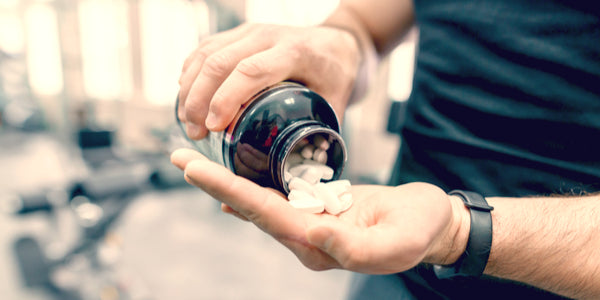
Selective androgen receptor modulators (SARMs) are chemicals that have been extensively evaluated as performance-enhancing agents. This is due to the potential of SARMs to help build muscle and, therefore, are alternatives to anabolic steroids.
While these sound like positive side effects, SARMs are still under investigation and knowledge of the way they work is still under evaluation. Their ability and anabolic effects make them interesting to fitness-minded communities and the potential for abuse and misuse exists.
Read on to learn about SARMs side effects, health risks, legality, and much more.
What Are SARMs?
SARMs are essentially drugs made of small chemical compounds, and their function depends on how they are structured. This chemical has been studied intensely due to its anabolic properties, or the qualities that can help it have a beneficial, building effect on the body.
In the clinical environment, SARMs have been applied to severe illness and have even been shown by some studies to reverse muscle wasting in cases where patients are extremely affected by their condition.
However, SARMs have not been approved by the FDA yet are widely available and used without any real attention to the serious side effects for the general, healthy population. More study is needed to substantiate claims that SARMs are safe for regular use, especially for fitness-focused users.
Are They Legal in the United States?
The Food and Drug Administration (FDA) has not approved SARMs, however many "black market" sources make them available for purchase online. These sources are often unverified yet easily accessible, and their only "evidence" is widespread anecdotal accounts and non-professional advice.
Many also lack the third-party certification which verifies the identity of the manufacturer, the content of the supplemental product, and attests to the amount or purity of ingredients. A product not known to meet these requirements could contain any number of dangerous and illegal additives.
The World Anti-doping Agency (WADA) has banned SARMs in sports since 2008. This decision was made on the basis of their potential for abuse, chemical impurities in supplements sold online, and false product claims that run rampant in this industry.
According to the FDA, products marketed as performance-enhancing sports supplements are among those most often to be deceptively labeled, adulterated, and fraudulent.
Side Effects of SARMs
In the medical field, SARMs have been thought of as a potential therapy option due to their relatively few side effects compared to the traditional treatments available.
That being said, a large gap in scientific study exists since long-term, casual use for performance-enhancing reasons has not been studied sufficiently to make recommendations for the population at large.
Non-Pharmaceutical Grade Substances
According to the Office of Dietary Supplements, products purchased on the "black market" are likely to contain the following, which include toxins that can impede health progress:
• Impure ingredients
• Unsafe levels of contaminants
• Deceptive labeling
• Undeclared substances
Liver Damage & Toxicity
The human liver helps to process toxins that enter the body. SARMs are by nature synthetic and are designed to mimic the effects of the body's natural hormones.
If products are taken on a regular regimen and are found to be tainted, they can cause serious health problems and significant symptoms that can overwhelm the liver and ultimately other body systems as well.
Some of the possible symptoms of liver damage and toxicity include:
• Nausea
• Weakness
• Fatigue
• Fever
• Abdominal pain
• Chest pain
• Shortness of breath
• Jaundice (skin and eye yellowing)
• Discolored or brown urine
Metabolism
Scientific studies show that different SARMs have different fates when it comes to how they are distributed and metabolized in the body. Metabolic studies and clinical trials are essential to identifying markers that indicate whether or not the drug is effectively working as intended in the human body.
Most drug therapies that have been testing SARMs are on adult subjects suffering from severe catabolic (the opposite of anabolic, or building) processes. In their cases, SARMs seem to correct a deficiency.
However, little is known about how SARMs can alter the wellbeing of a generally healthy person, and very little is known about their long-term effects with casual use or disease-free adults.
Whole Body Health
For SARMs to be used to their full therapeutic threshold, ideally they would operate in a tissue-selective manner. This means that to be beneficial, SARMs should be part of a supervised drug therapy where the active reactions used for treatment are closely monitored to determine if beneficial effects are correcting deficiencies.
Used for a specific problem without the medical direction of a professional, SARMs can wreak havoc on the body by interfering with its systems, including the systems used to send messages throughout the body to regulate important day-to-day functions.
Potential complications caused by SARMs include:
• Fluid retention
• Blood pressure increase
• Over or under stimulation of certain body process
• Interaction with medications
• Reduction of the effectiveness of nutrients and/or therapy protocols
The Bottom Line
SARMs are not approved for the general population. They are also still being studied for effectiveness in the most serious of clinical cases.
The highest reward for the lowest risk is a nutrient-dense diet is balanced with a healthy amount of exercise. Besides, many safe practices for muscle building and enhancing performance exist without the side effects and increased risks of SARMs.
References:
Christiansen AR, Lipshultz LI, Hotaling JM, Pastuszak AW. Selective androgen receptor modulators: the future of androgen therapy?Transl Androl Urol. 2020;9(Suppl 2):S135-S148. doi:10.21037/tau.2019.11.02
Geldof L, Pozo OJ, Lootens L, Morthier W, Van Eenoo P, Deventer K. In vitro metabolism study of a black market product containing SARM LGD-4033. Drug Test Anal. 2017;9(2):168-178. doi:10.1002/dta.1930
Giagulli VA, Silvestrini A, Bruno C, Triggiani V, Mordente A, Mancini A. Is There Room for SERMs or SARMs as Alternative Therapies for Adult Male Hypogonadism? Int J Endocrinol. 2020;2020:9649838. Published 2020 Jan 21. doi:10.1155/2020/9649838
Office of Dietary Supplements. Dietary Supplements for Exercise and Athletic Performance, Fact Sheet for Professionals. National Institutes of Health. 2020. https://ods.od.nih.gov/factsheets/ExerciseAndAthleticPerformance-HealthProfessional/#en212.
Solomon ZJ, Mirabal JR, Mazur DJ, Kohn TP, Lipshultz LI, Pastuszak AW. Selective Androgen Receptor Modulators: Current Knowledge and Clinical Applications. Sex Med Rev. 2019;7(1):84-94. doi:10.1016/j.sxmr.2018.09.006







